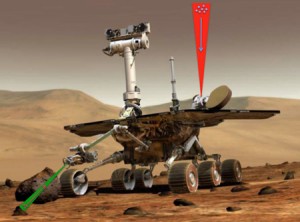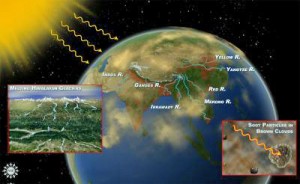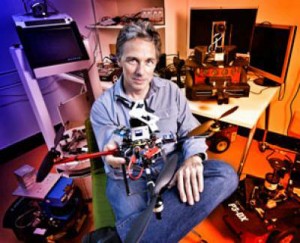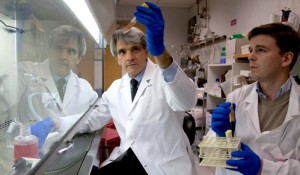
NASA scientists are working to corral particles and transport them via laser light. Concept image courtesy Dr. Paul Stysley
Fans of “Star Trek” or “Star Wars” are familiar with tractor beams; Darth Vader used the powerful beam to capture a spacecraft carrying Luke and Han Solo in Star Wars Episode IV, “A New Hope.” (corrected)
Aside from capturing the enemy and preventing their escape , the tractor beams could also retrieve or tow various objects.
Of course, that was science fiction. But it just moved a little closer to reality.
A team of scientists from NASA’s Goddard Space Flight Center in Greenbelt, Md., recently won $100,000 in funding to study the concept of remotely capturing particles and delivering them to a robotic rover or orbiting spacecraft for analysis.
The NASA team will study three experimental methods of transporting various particles with a laser light; experiments NASA compares to a vacuum suctioning and transporting dirt to a canister or bag.
The team has identified three different approaches for transporting particles – as well as single molecules, viruses, ribonucleic acid, and fully functioning cells – using the power of light.
Although this laser-based trapping technology has only appeared in science fiction, NASA scientists say it really isn’t that fancy, or even beyond current technological knowledge.
So what will scientists think of next? Personally, I look forward to the day someone figures out how to make a “Star Trek”-like people transporter.
Beam me up, Scotty!
Pollution Intensifies Cyclones

Scientists are working to better understand atmospheric brown clouds and their effects. (Image: Nicolle Rager Fuller, National Science Foundation)
Pollution is making Arabian Sea cyclones more intense, according to a study published this week in Nature.
In the past, prevailing wind shear patterns have kept the Arabian Sea cyclones from turning into major storms.
The study suggests weakening winds have allowed for the formation of stronger cyclones in recent years. That includes the first recorded storms – in 2007 and 2010 – ever to enter the Gulf of Oman.
Researchers link weakening wind patterns in the last 30 years to a buildup of aerosols in the atmosphere over India. An increase in atmospheric aerosols causes sunlight to be deflected from the earth’s surface, which creates a dimming effect at ground level. Scientists say that this dimming may be responsible for more intense cyclones.
The buildup of aerosols creates formations known as atmospheric brown clouds (ABCs), in which smog from diesel emissions, soot and other byproducts of burning biomass accumulate and become widespread enough to affect regional climate.
There is an upbeat side to the study. Its authors suggest the atmospheric concentrations of pollutants can be quickly and drastically reduced using currently-available technologies.
A Suitcase Full of Robots

Peter Corke, from Queensland University of Technology in Australia, with his flying robot. (Photo: Erika Fish)
Imagine having a tiny robot which would be able do a number of tasks, from making deliveries and conducting inspections, to serving as farm hands.
The robotics team at the Queensland University of Technology (QUT) in Australia, is working on it.
The miniaturized, propeller-powered robots have multiple cameras, which allow them to ‘see’ the world around them as they make their way through buildings and carry out their tasks. The researchers hope to attach arms to the devices, so they’ll be able to fix things, too.
According to the researchers, the cost-effective technology they’re using will make the robots affordable.
Right now, the team is busy working out technical challenges; like keeping the robots protected in hazardous areas and making sure they’re able to keep their position despite strong winds.
New Drug Shows Promise for Treating MS

Research team members Stephen Hauser, MD, and Pierre-Antoine Gourraud, PhD, in the lab at UCSF. (Photo: USCF)
More than two million people around the world have multiple sclerosis, a chronic, often-disabling disease that attacks the central nervous system. Usually striking young adults, MS is more common in women than in men.
So far, there is no cure but current research at the University of California, San Fransisco shows promising results with an experimental drug called Ocrelizumab.
The phase 2 clinical trial involved 220 people with MS. The patients were divided into four groups. Two received injections of Ocrelizumab at two different doses, one got the standard MS drug, interferon-beta, and the final “control” group was given a placebo.
Patients who received the Ocrelizumab generally showed fewer signs of MS than those who received either the standard interferon treatment or the placebo.
Overall, Ocrelizumab led to a 89-percent reduction in the formation of brain lesions, a hallmark of the disease. It also reduced the number of new multiple sclerosis attacks over 24 weeks.
Also, the short-term study showed that interferon performed no better than placebo.
The next step for the drug’s development will come in two parallel phase 3 trials. Researchers will determine if the drug’s effect and positive safety profile can be sustained over time.





















The tractor beam was used in “A New Hope”, not “The Empire Strikes Back”.
Sean – You are correct… of course its from Star Wars Episode IV, “A New Hope” – the first Star Wars movie that was released (back in 1977). thanks for pointing it out! Correction made above too.